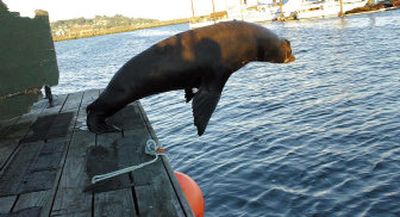Branding helps track sea lions

ASTORIA, Ore. – It’s 6:30 a.m. in Astoria’s East Mooring Basin. The sun is just coming up, boats are leaving the harbor for a day of fishing, and six men sneak up and drop a cage door on 11 California sea lions lying on a floating trap in the harbor.
Now the men, all employees of the Oregon Department of Fish and Wildlife, corral the animals into a series of smaller cages tied together on a connecting barge, where hot branding irons are waiting to number their hides.
A cacophony of barking fills the harbor from the dozens of sea lions lying on the dock nearby. California sea lions are a type of marine mammal called a pinniped, and hundreds of them travel up the Columbia River every year to find food in between mating seasons.
The Port of Astoria has conceded an entire dock to these hefty pinnipeds, some weighing as much as 800 pounds. The floating cage sits beside the dock, luring sea lions to sleep on it at night. When the cage door slams shut, the sea lions inside waddle and flop together in a corner, their sack-like bodies piled on top of one another as their whiskered faces yelp and bark.
The men, led by department biologist Matt Tennis, bang on the sides of the cage to scare the sea lions into a smaller trap on the barge, where the branding takes place. The first sea lion to go onto the barge is often a veteran, one that’s already been branded, according to Tennis.
“That shows me the procedure isn’t harsh on them,” he said. “Usually, a pilot sea lion will lead the others through. One has been through 17 times. It’s the naive ones that are scared; they haven’t been through yet.”
When an unmarked sea lion passes through the cages on the barge, he lands in the metal claws of a collapsible trap that looks like two warped bike racks fitted together on a hinge. He groans and squirms as the bars close down on him. The trap holds the animal in place while department workers take measurements and attach tags to both flippers.
The back quarter of the trap is then opened to reveal a section of the sea lion’s backside.
Tennis stands on top of the trap and steadies the hide with his foot while Bucky Barnett hands him a glowing red branding iron. The hot metal hisses as it touches the sea lion’s fur, and an acrid, yellow smoke billows out from the trap and hovers over the barge.
The sea lion is quiet as Tennis burns a permanent “C” into his skin. Tennis proceeds to burn the numbers 5, 8 and 3 onto the animal’s back, each with a separate branding iron – none of them eliciting so much as a groan. When the branding is done, officials open the claws of the trap, and C583 hops out and splashes off the barge.
From now on, this sea lion will be known as the 583rd captured on the Columbia River since the department started the branding program in 1997.
Why brand a sea lion? As the original sea lion project leader in Astoria, Barnett started studying the impact of fishermen on sea lions in 1990. But over the years the key issue has become how sea lions affect salmon.
Sea lions are protected under the Marine Mammal Protection Act, which imposes strict rules on how they can be handled. However, certain sea lions, like the ones that have been preying on fragile salmon runs passing through Bonneville Dam, could qualify for an exception under the law.
And the branding program helps officials identify the culprits. “We wanted to see which ones were the bad guys,” he said. “It quickly became ‘We’re not too worried about marine mammals; we’re worried about the fish.’ You had protected animals versus endangered salmon.”
With the permanent brands on their backs, the individual sea lions preying on salmon can be studied year after year and targeted for federal, and possibly lethal, removal.
Program director Robin Brown said sea lions can pretty much wriggle out of any external tag, and they shed anything put on their fur when they molt. He said the branding method is the only way to make a permanent mark and study the individuals over longer periods of time.
The branding program has helped the U.S. Army Corps of Engineers count the number of sea lions at Bonneville each year and estimate their impact on salmon. This year, data indicates 85 individual sea lions picked off 2.8 percent of the spring salmon run at the dam, not including predation on more than 100 river miles leading up to it.
Not all sea lions have a taste for salmon, according to Tennis. But the ones that do – “those are the ones you see at Bonneville Dam year after year,” he said.